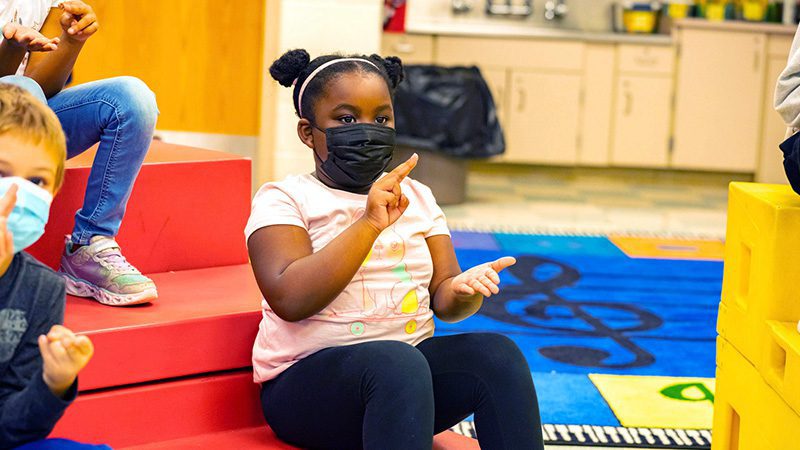Thomas Jefferson Elementary
Propelling Academic Growth and Acceleration from a Foundation of Strong, Trusting Relationships
By Courtney Wise-Randolph
At the end of recess one afternoon, a group of first and second graders at South Redford’s Thomas Jefferson Elementary are spread out in their own play bubbles to keep them safe from the ongoing COVID-19 pandemic, enjoying a few minutes of unstructured playtime.
As the 80 or so students line up to head inside, their principal, James Kinsey, moves from the center of the outdoor blacktop to the door. With each stride, he greets a different student. It’s the end of the fourth week of school, and at this point, he knows all 253 children by name.
“Hello everyone, how are you? Thank you for getting those masks on.”
“How’s it going, Neil?”
Neil looks up as another students yells, “Neil’s been doing good!”
Mr. Kinsey replies with a chuckle, “Alright, Neil, my man! That’s what I want to hear.”
He takes two more steps.
Amid the flock of waves and chorus of “Hi, Mr. Kinsey!” a student shouts, “Hey, scoot up!”
With a quick glance, he says quietly but firmly, “I think there’s a better way to say that.”
“Please, scoot up,” the student says.
“That’s definitely it,” Principal Kinsey replies with a smile.
On the playground, in the hallways, and especially in the classrooms at Jefferson, there is a lot of that — a palpable sense that the adults in the building know the students they’re responsible for teaching. The school environment also reflects an intentionality to effectively teach, while constantly curating an environment where it is healthy for children to learn.
“Right now,” said Kinsey, “our [school’s] mission is that we’re a community of leaders who are safe and kind. We just want to get kids where they need to be academically, behaviorally, and socially. Wherever that ‘need to be’ is, we pay attention to [that] and then we start working from there.”
That bottom line strategy is working for students.
Right now,” said Kinsey, “our [school’s] mission is that we’re a community of leaders who are safe and kind. We just want to get kids where they need to be academically, behaviorally, and socially. Wherever that ‘need to be’ is, we pay attention to [that] and then we start working from there.”
Principal

Since 2017, Thomas Jefferson has proven to be a high-growth school — a place where more students at the school are learning at faster rates than the majority of peers across the state, as shown by Michigan’s annual student tests. This is particularly true for its subgroups of students, including Black students and students attending the school that come from low-income backgrounds.
One critical instructional component that has attributed to this academic success, according to the staff, is the school’s adoption of Success For All, or SFA, an intensive school reform model that fosters cultural change and helps to build community across the whole school.
Schools that use the SFA model are required to convene committees focused on student attendance, cooperative culture, interventions, parent and family involvement, and community connections. These actions foster strong, trusting relationships between students and their families and schoolteachers and leaders, yielding greater academic outcomes for students.
In addition, with the SFA literacy program, students purposefully leave their homeroom classroom to work in an entirely different classroom, with a different teacher and reading level.
The model has changed the mindset of the school community into one that is intensely focused on launching students toward academic growth and mastery in a highly encouraging, supportive and united school environment.


Instructional coach Kay Shufeldt said, “We talk about students’ behaviors or academics across grades and across teachers because my homeroom student that’s with me most of the day is going to [someone else] now for reading. So, it’s not just an idea of ‘these 30 kids in this room are mine.’ They’re actually shared, and [teaching them] is a shared responsibility.”
To expedite math growth, in addition to its Bridges math curriculum, the school has adopted Accelerate, an intensive intervention program used by educators in Louisiana when schools were long closed in the aftermath of Hurricane Katrina. It’s proven effective, particularly in the unfinished learning environment of COVID-19.
In some schools, remediation to close learning gaps yields minimal progress, putting students who are behind in the position of forever playing catch up. In contrast, Shufeldt says, Accelerate effectively trains teachers to instruct students in the units they still need to master alongside grade level content. This ensures that students do not continue to fall behind and have an opportunity to progress.
“Research shows that acceleration actually boosts kids and closes gaps faster than if you’re just plugging holes,” Shufeldt said, “because if you [just] plug the holes here and they don’t have the [new grade-level] learning now, they’re going to constantly be behind.”
Rather than take short steps with remediation for students who are behind, Jefferson implements proven strategies to help students sprint towards exceptional student growth.
And when students have success, parents notice. One parent, a mother of two children, one who graduated from Jefferson three years ago and another who is a current Jefferson student, said that she has long been pleased with the quality of education her children receive at the school, and she’s even more pleased since recent enhancements to the school’s culture.
“They use evidence-based teaching strategies and interventions, and I think it’s a great place [with a] great culture,” she said. The parent went on to applaud Kinsey, in particular, for demonstrating a “level of cultural competency, awareness and ability” that she had not before seen.